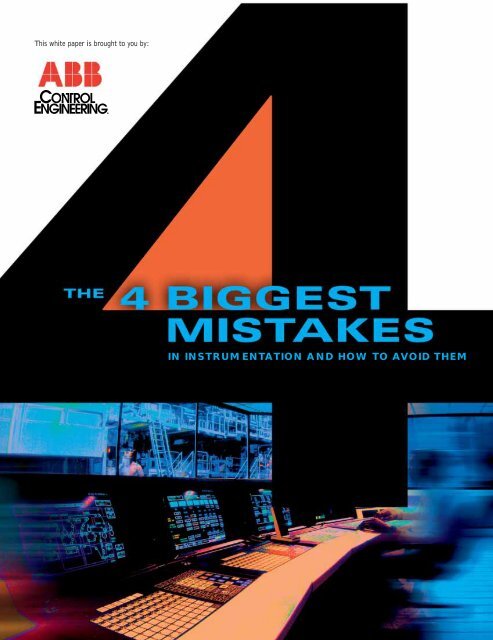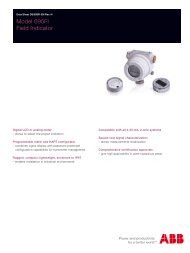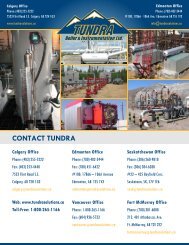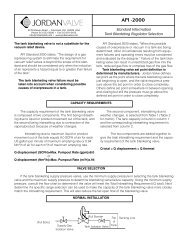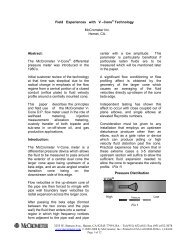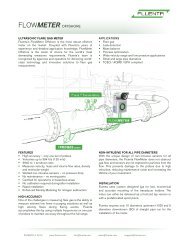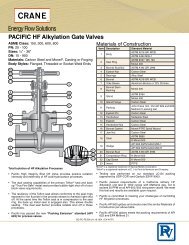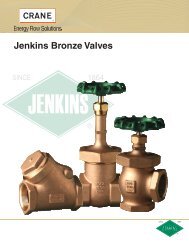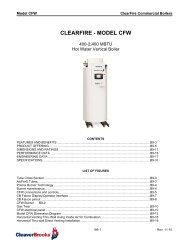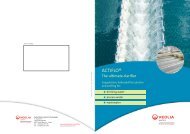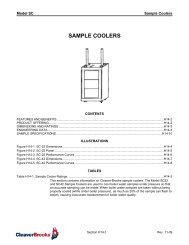4 Biggest Mistakes In Instrumentation And How to Avoid Them - Our ...
4 Biggest Mistakes In Instrumentation And How to Avoid Them - Our ...
4 Biggest Mistakes In Instrumentation And How to Avoid Them - Our ...
You also want an ePaper? Increase the reach of your titles
YUMPU automatically turns print PDFs into web optimized ePapers that Google loves.
This white paper is brought <strong>to</strong> you by:IN INSTRUMENTATION AND HOW TO AVOID THEM
1THE FOUR BIGGEST MISTAKES IN INSTRUMENTATION ..The problem lies in the straightforward natureof instrumentation projects: each variable <strong>to</strong> bemeasured must be matched with the mostappropriate sensor; the sensor must beinstalled, calibrated, and interfaced <strong>to</strong> the controller;and the information generated by thesensor must be filtered, fac<strong>to</strong>red, and filed inorder <strong>to</strong> give the controller an accurate pictureof what’s going on in the process. This apparentsimplicity is what often leads <strong>to</strong> a falsesense of security and missteps in a minefieldof potential problems.With that in mind, here are four circumstancesyou definitely want <strong>to</strong> avoid.>> Mistake #1:Selecting the wrongsensorTechnology mismatchDespite ongoing advancements in measurementand communications technology, instrumentinga process for feedback controlremains a technical challenge. Today’s sensorsare certainly more sophisticated than everbefore, and fieldbus technology has simplifiedmany installation issues considerably.Nonetheless, much can still go wrong with aninstrumentation project.Although it’s generally obviouswhat quantity needs <strong>to</strong> be measuredin a flow, temperature, orpressure control application, it’s notalways obvious what kind of flowmeter, temperature sensor, or pressuregauge is best suited <strong>to</strong> thejob. A mismatch between the sensingtechnology and the material <strong>to</strong>be sensed can lead <strong>to</strong> skewedmeasurements and severelydegraded control.This is especially true whenmeasuring flow rates. All flowmeters are designed <strong>to</strong> measurethe rate at which a gas or liquidhas been passing through a particularsection of pipe, but not all flowmeters can measure all flows. Amagnetic flow meter or magmeter,for example, can only detect theflow of electrically conductivematerials by means of magneticinduction. Non-conductive fluidslike pure water will pass through amagmeter undetected.Magmeters also have troubledistinguishing air bubbles from thefluid in the pipe. As a result, amagmeter will always yield an artificiallyhigh reading when bubblespass through because it cannotsense the decrease in fluid volumecaused by the presence of thebubbles. <strong>In</strong> a feedback loop, thisoccurrrence would cause the controller<strong>to</strong> throttle back the flow ratemore than necessary, preventingthe required volume of fluid fromreaching the downstream process.The problem gets even worse ifthe pipe is so full of air that it isonly partially filled with liquid, acondition known as open channel.Although recent technological innovationsallow certain magmeters <strong>to</strong>work in such a challenging environment,mechanical sensors such asturbines yield artificially high readings,since a trickle of fluid willmove the meter’s mechanism justas much as a full-pipe flow travelingat the same speed. On theother hand, mechanical sensorsare not affected by the conductivity
AND HOW TO AVOID THEM 3of the fluid, so they will sometimeswork where magmeters fail.An even more challenging applicationis the measurement of pH ina caustic liquid such as the slurriesfound in paper mills. A general-purposepH probe made of corrodiblematerials might not only generateinaccurate data, it might die al<strong>to</strong>gether,sometimes within a matterof days. Some probes, such asthose offered by ABB, are specificallydesigned for such <strong>to</strong>ugh environments.They can double, triple,and even quadruple probe life inmany applications.The trick is <strong>to</strong> find the right technologyfor the application, or <strong>to</strong>choose instruments that span abroader range of solutions. Forexample, new digital technologiesallow some flow meters <strong>to</strong> solvemany more flow problems thantheir predecessors.<strong>In</strong>strumentation vendors can beof help in avoiding the technologymismatch mistake. The best vendorstrain their sales people <strong>to</strong>assist with sensor selection andprovide clients with easy-<strong>to</strong>-useselection guides. Some even offerextensive look-up tables based onproduct number, application, andserial numbers of past installations—an especially useful service whenreplacing older products.Finding all the right parts canalso be a challenge. Some instrumentsrequire specific housings,mounting hardware, and transmitters<strong>to</strong> forward the sensor’s data <strong>to</strong>the controller. The right vendor canmake all the difference by providingthe entire assembly under asingle catalog number. When itcomes <strong>to</strong> temperature instrumentation,for example, training costsand purchasing effort are reducedwhen then vendor offers compatibleprobes and transmitters <strong>to</strong>getheras a package.Paying <strong>to</strong>o much (or <strong>to</strong>o little)Correct sensor selection is also amatter of balancing cost againstperformance. When there’s achoice of equally effective technologies,the right choice is generallythe cheapest one that gets thejob done.Temperature instrumentation is aclassic example. The two dominanttechnologies are resistance temperaturedetec<strong>to</strong>rs (RTDs) andthermocouples. An RTD consists ofa metal plate or rod through whicha current is passed. The resistancethat the current encounters varieswith the temperature of the metal. Athermocouple consists of two dissimilarmetal wires joined <strong>to</strong>getherat one end. The voltage betweenthe unjoined ends varies with thetemperature of the joint. Both yieldvoltages that can be electronicallyinterpreted <strong>to</strong> indicate the temperatureof the surroundings.Thermocouples are generallycheaper, though less accurate thanRTDs. If the application does notrequire particularly tight temperaturecontrol, an inexpensive thermocoupleand a well-tuned PID loopshould do the trick. But for processesthat will only work correctly atvery specific temperatures, it wouldbe a mistake not <strong>to</strong> pay for thegreater accuracy that an RTDaffords. The cost of scrapping abatch of under-cooked or scorchedproducts would eventually dwarfany savings in equipment costs.A fast sensor can also be worththe extra cost. If the processrequires a rapid succession ofheating and cooling cycles, thetemperature sensor must be able<strong>to</strong> generate a reading before it’s <strong>to</strong>olate <strong>to</strong> be of any use. Despite theircheaper pedigree, thermocouplestend <strong>to</strong> respond faster than RTDs—so if speed is the only importantperformance issue, choose athermocouple.>> Mistake #2:<strong>In</strong>stalling sensors2incorrectlyPlacementThe best sensor can yield disappointingresults if not installed correctly.Magmeters, for example,tend <strong>to</strong> generate noisy signals if theflow they’re measuring is turbulent.Bends, junctions, and valves in apipe can all cause turbulence, thusmagmeters work best wheninstalled in sections of straightpipe.Temperature sensors are alsosensitive <strong>to</strong> placement. Even ahighly accurate RTD tucked in thecorner of a mixing chamber willonly be able <strong>to</strong> detect the temperatureof its immediate vicinity. If themixing of the material in the chamberis incomplete, that local temperaturemay or may not representthe temperature of the materialelsewhere in the chamber.Local temperature issues arethe classic mistake that home heatingcontrac<strong>to</strong>rs often make wheninstalling household thermostats. A
THE FOUR BIGGEST MISTAKES IN INSTRUMENTATION ..mounting location closest <strong>to</strong> thefurnace may be convenient forwiring purposes, but if that spothappens <strong>to</strong> be in a hallway or otherdead air space, the thermostat willnot be able <strong>to</strong> determine the averagetemperature elsewhere in thehouse. It will only be able <strong>to</strong> maintainthe desired temperature in itsimmediate vicinity. The rest of thehouse may end up roasting orfreezing.Controller performancePoor control also results when asensor is installed <strong>to</strong>o far awayfrom the associated actua<strong>to</strong>r. A distantsensor may not be able <strong>to</strong>measure the effects of the actua<strong>to</strong>r’slast move in time for the controller<strong>to</strong> make an educated decisionabout what <strong>to</strong> do next.For example, consider theprocess of flattening hot steel in<strong>to</strong>uniform sheets by means of twoopposing rollers (see Figure 1). Athickness sensor downstream fromthe rollers gauges the sheet andcauses the controller <strong>to</strong> applyeither more or less pressure <strong>to</strong>compensate for any out-of-specthickness.Ideally, the thickness sensorshould be located adjacent <strong>to</strong> therollers <strong>to</strong> minimize the timebetween a change in roller pressureand the resulting change inthe thickness measurement.Otherwise, the controller will not beable <strong>to</strong> detect any mistakes it mayhave been making soon enough <strong>to</strong>prevent even more of the sheetfrom turning out <strong>to</strong>o thick or thin.Worse still, an appreciable deadtime between the controller’sactions and the resulting effects onthe steel can cause the controller<strong>to</strong> become impatient. It will see noresults from an initial control move,so it will make another and anotherFIGURE 1. POOR SENSOR PLACEMENTADJUSTABLEROLLERFIXEDROLLERPISTONCONTROLLERDOPTICALTHICKNESSGAUGE<strong>In</strong> this steel rolling example, D is the distance between the steel rollers and the thicknessgauge downstream. If D is <strong>to</strong>o large, the controller will take <strong>to</strong>o long <strong>to</strong> correct thicknesserrors and may even make matters worse by becoming impatient.until some change begins <strong>to</strong>appear in the measurementsreported by the sensor. By thattime, the controller’s cumulativeefforts will have already overcompensatedfor the original error,causing an error in the oppositedirection. The result will be a constantseries of up and down swingsin the roller pressure and a lot ofsteel ruined by lateral corrugations.Of course, overall process performanceconsiderations aren’t limited<strong>to</strong> how well the sensor feedsdata <strong>to</strong> the controller during operation.Other fac<strong>to</strong>rs <strong>to</strong> considerinclude ease of installation andtime spent on the selectionprocess, set up routines, and anylabor-intensive maintenance.Fortunately, some instrumentationvendors design their sensors <strong>to</strong>accommodate such challenges,thereby improving performancebefore the system even goes online.ABB, for instance, offers aswirl flowmeter that significantlyreduces the need <strong>to</strong> install specialupstream and downstream devices<strong>to</strong> accurately measure the flowthrough a pipe.ProtectionA steel mill is also a classic exampleof a harsh environment that candestroy inadequately protectedsensors. Fortunately, the hazardsposed by a manufacturing processare generally obvious and can oftenbe overcome by installing a shieldor choosing a rugged instrument.Often overlooked, however, arethe effects of weather. Outdoorinstruments can take quite a beatingfrom rain, snow, hail, and falling
AND HOW TO AVOID THEM 5FIGURE 2. POOR MOUNTINGEven the orientation of an instrument can affect its performance. Here, the sensoris enclosed in a housing designed <strong>to</strong> dissipate the heat it generates. The fins mustbe mounted vertically <strong>to</strong> allow warm air <strong>to</strong> escape.ice. Over time, outdoor instrumentscan fail slowly unless enclosed inappropriate housings.But even the housings themselvescan cause problems for theenclosed instruments, particularlytemperature sensors. If an RTD orthermocouple is mounted on thesame piece of metal that supportsthe housing, the housing will worklike a heat sink when the ambienttemperature drops low enough. Itwill tend <strong>to</strong> draw heat out of thesensor and artificially lower itsreading. The heat-sink effect willalso tend <strong>to</strong> reduce the benefits ofany internal heat that has beenapplied <strong>to</strong> prevent an instrumentfrom freezing.Conversely, if a housing isequipped with fins intended <strong>to</strong>draw heat out of the enclosed sensorduring warm weather, the finsmust be mounted vertically.Otherwise, the warm air around thefins will not be able <strong>to</strong> rise awayfrom the housing (see Figure 2).Ground loopsWhile it’s generally a good practice<strong>to</strong> insulate a sensor from the thermodynamiceffects of its surroundings,it’s absolutely critical <strong>to</strong> establishelectrical isolation. The mostcommon electrical problems due <strong>to</strong>poor installation are ground loops.Ground loops occur when anextraneous current flows throughthe instrumentation wiring betweentwo points that are supposed <strong>to</strong> beat the same voltage, but aren’t (seeFigure 3). The resulting electricalinterference can cause randomfluctuations in the sensors’ outputand may even damage the sensorsthemselves.As the name implies, groundloops most often occur when instrumentsand their cables are groundedimproperly or not at all.<strong>In</strong>terestingly, the best way <strong>to</strong> isolatea plant’s instruments from groundloop currents is <strong>to</strong> connect them<strong>to</strong>gether at one master groundingpoint.If that’s not possible, a grid ofgrounding points must be spreadthroughout the plant, making surethat all points on the grid are atthe same electrical potential.<strong>In</strong>secure connections and inadequatewires can cause a voltageimbalance in the grid and groundloops between the instrumentsconnected <strong>to</strong> it.FIGURE 3. POOR GROUNDINGGround loop currents}Data signals<strong>to</strong> I/O panel}<strong>In</strong>struments}Earth grounds atunequal voltages<strong>In</strong>struments must begrounded <strong>to</strong> providea reference voltagefor the data signalsthey generate.Relying on earthground is risky sincenot all of the earthshares the sameelectrical potential.The resulting currentswill interfere with thesensors’ signals.
THE FOUR BIGGEST MISTAKES IN INSTRUMENTATION 4..>> Mistake #3:an inch. Whether those flaws are should be applied in the finalGenerating gibberish appreciable or not will depend on stages of the project, just beforethe amplitude of the original noise loop tuning.Noisesignal, the inertia of the rollers, andthe tuning of the controller. Mistake #4:PID controllers tuned <strong>to</strong> provide Quitting <strong>to</strong>o soonappreciable derivative action are Even when the data filters are inparticularly susceptible <strong>to</strong> the place and the last loop has beeneffects of measurement noise. They tuned, the project isn’t over. Theretend <strong>to</strong> react aggressively <strong>to</strong> every are some commonly neglectedblip in the measurement signal <strong>to</strong> chores that should continue asquickly suppress deviations from long as the instrumentation systemthe setpoint. If a blip turns out <strong>to</strong> is in place.be nothing but noise, the controllerwill take unwarranted corrective Calibrationactions and make matters worse.Ground loops are not the onlysource of noise that can dis<strong>to</strong>rt asensor’s readings. Radio frequencyinterference (RFI) is even morecommon in plants that use walkietalkies,pagers, and wireless networksextensively. RFI also resultswhenever a current changes, suchas when an electromechanical contac<strong>to</strong>r a static discharge generatesa spark.The sources of RFI noise mustbe eliminated or at least kept awayfrom the plant’s instrumentation if atall possible. Replacing electromechanicalequipment with solidstatedevices will eliminate arc-generatedRFI. Or, it may be sufficient<strong>to</strong> simply relocate switch boxesand relays <strong>to</strong> instrument-free areasof the plant. If all else fails, it maybe possible <strong>to</strong> passively shield the3source of the interference or theinstruments being subjected <strong>to</strong> it.Ignoring the problem is not anoption, especially when the sourceof the noise is ordinary house current.At 60 Hz, house current oscillatesslowly enough <strong>to</strong> have anappreciable effect on someprocesses.Consider the steel rolling applicationagain. A 60 Hz noise superimposedon the output of the thicknessgauge will pass through thecontroller and induce a 60 Hz oscillationin the roller pressure. If thesheet exits the rollers with a velocityof six feet per second, thoseoscillations will appear as bumps inthe sheet appearing every tenth ofFilteringUnfortunately, it is not always possible<strong>to</strong> eliminate noise sourcesal<strong>to</strong>gether. It is often necessary <strong>to</strong>filter the raw sensor data by averagingseveral samples <strong>to</strong>gether orby ignoring any changes less thansome small percentage. Many digitalinstruments, like ABB’s FSM4000 flowmeter, come equippedwith built-in filters.<strong>How</strong>ever, it is a mistake <strong>to</strong> thinkthat number crunching alone canfix all measurement noise problems.Filtering tends <strong>to</strong> increase thetime required <strong>to</strong> detect a change inthe measured value and can evenintroduce spurious information in<strong>to</strong>the signal. Worse still, it can maskthe actual behavior of the processif it is overdone.It is generally more cost-effectivein the long run <strong>to</strong> install sensorscorrectly and minimize thesources of interference than <strong>to</strong> relystrictly on mathematics <strong>to</strong> separatethe data from the noise. When constructinga control loop, data filtersMost instrumentation engineersknow that a sensor must be calibratedin order <strong>to</strong> associate anumerical value with the electricalsignal coming out of the transmitter.Yet all <strong>to</strong>o often, the instruments arecalibrated just once during installationthen left <strong>to</strong> operate unattendedfor years.The result is an insidious problemknown as drift. A sensor’s outputtends <strong>to</strong> creep higher and higher(or lower and lower), even if themeasured variable hasn’t changed.Deposition on the sensing surfaces,corrosion in the wiring, andlong term wear on moving partscan all cause an instrument <strong>to</strong>begin generating artificially high (orlow) readings. As a result, the controllerwill gradually increase ordecrease its control efforts <strong>to</strong> compensatefor a non-existent error.Analog instruments are particularlysusceptible <strong>to</strong> drift, much likeold FM radios. The slightest nudgeon the dial could cause the radio <strong>to</strong>lose its signal. With modern digitalradios, the one true frequency foreach station is digitally encoded at
AND HOW TO AVOID THEM7a fixed value. Similarly, moderninstruments that employ digital signalprocessing can’t be “nudged.”They maintain the same calibrationin the field as in the lab.Drift can also be reduced by thechoice of sensing technology.Temperature sensors with mineralinsolated cables, for example, areless prone <strong>to</strong> drift. Drift due <strong>to</strong> wearcan be eliminated entirely bychoosing instruments with no movingparts, like ABB’s swirl and vortexmeters.<strong>And</strong> even when drift cannot beeliminated, recalibrating every sensorin the plant at intervals recommendedby their manufacturerscan accommodate it. Unfortunately,project engineers are often so anxious<strong>to</strong> finish a job and get on withoperating the process that theyneglect such basic maintenance.Arguably the most challengingsources of drift are those that varyover time. Deteriorating probes andmoving parts beginning <strong>to</strong> wear outcan slowly change an instrument’saccuracy. So maintenance calibrationis required periodically even ifthere are no known issues with theinstrument.Some manufacturers are recognizingthe time and efforts involvedin traditional recalibration exercisesand are designing instrumentationproducts <strong>to</strong> simplify matters. Forexample, the CalMaster portablecalibra<strong>to</strong>r from ABB provides in-situcalibration verification and certificationof ABB’s MagMaster electromagneticflowmeters without requiringaccess <strong>to</strong> the flowmeter oropening the pipe.<strong>In</strong>stead, the opera<strong>to</strong>r simplyconnects a CalMaster <strong>to</strong> theflowmeter’s transmitter and a PC. AWindows interface guides the opera<strong>to</strong>rthrough a series of tests <strong>to</strong>evaluate the status of the transmitter,sensor, and interconnectingcables. The tests are complex, butso au<strong>to</strong>mated that the whole calibrationroutine can be accomplishedin 20 minutes.Once the tests are complete,CalMaster will evaluate the measurementstaken. If all satisfy the calibrationrequirements, then a calibrationcertificate can be printed eitherat that time or later. These certificatescan then be catalogued inorder <strong>to</strong> meet auditing and regula<strong>to</strong>ryrequirements such as ISO 9001.An added benefit of CalMasteris that it can be used as a diagnosticand condition moni<strong>to</strong>ring<strong>to</strong>ol. It au<strong>to</strong>matically s<strong>to</strong>res allmeasured values and calibrationinformation in its own databasefiles for each meter, thus maintaininga calibration his<strong>to</strong>ry log andmaking it easier <strong>to</strong> undertake longtermtrend analysis. Detailedobservation can give early warningof possible system failure,enabling the maintenance engineer<strong>to</strong> anticipate problems andtake proactive remedial action.Such au<strong>to</strong>mated systems makeroutine verification of flowmeter calibrationand the traceability of informationmuch less cumbersomeand costly than in the past. <strong>In</strong> thewater industry, for example, suchtasks formerly entailed mechanicalexcavation of the flowmeter resultingin a disruption of the water supplyand a substantial investment inmanpower and equipment.Planning for the roadaheadAll <strong>to</strong>o often, an expansion projectbegins with weeks of wonderingwhy the existing instrumentationsystem was constructed theway it was and why it doesn’tmatch the project’s original plans.To avoid this, future planningshould be a part of your implementationprocess and alsoinclude thorough documentationof what’s been done before.Someone will eventually want <strong>to</strong>expand the project and will need<strong>to</strong> know exactly which instrumentshave been placed where,what the instruments were supposed<strong>to</strong> be accomplishing, andhow they were installed and configured.Even if the instrumentation systemis never expanded, it will eventuallyhave <strong>to</strong> be repaired. Wiresbreak and sensors wear out. Agood inven<strong>to</strong>ry of the system componentswill indicate what needs <strong>to</strong>be replaced, but that’s only half thebattle. Replacement parts must beacquired along with the technicalspecs necessary <strong>to</strong> install themcorrectly.An ongoing replacement partsprogram is a must. Either the originalvendor must make provisionsfor s<strong>to</strong>cking replacements (orupgrades) for all the instrumentsthey’ve provided <strong>to</strong> date, or theproject engineers must continue <strong>to</strong>moni<strong>to</strong>r their suppliers <strong>to</strong> makesure that spare parts remain available.For hard-<strong>to</strong>-find instruments, itmay even be necessary <strong>to</strong> maintainan in-house supply of replacementparts, just in case.


